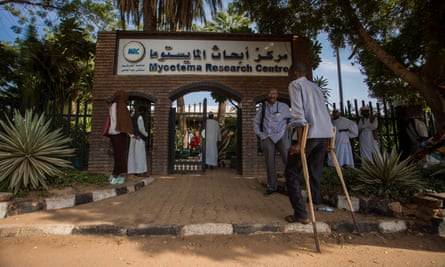Cheap fungal nail infection drug found to work on crippling flesh-eating disease
A cheap and easy-to-take drug used to treat fungal nail infections has proven highly effective against a devastating flesh-and-bone-eating disease found in Africa, Asia and the Americas.
Researchers say the breakthrough offers hope to thousands of patients who have suffered decades of neglect and could face amputations if the disease is left untreated.
Results from the first clinical trial for a new treatment for mycetoma, which took place in Sudan, have shown that the oral drug fosravuconazole is up to 85% effective and has no side effects.
Dr. Borna Nyaoke, head of mycetoma at the Drugs for Neglected Diseases Initiative (DNDi) – which coordinated the trial with the Mycetoma Research Center (MRC) in the Sudanese capital Khartoum, and the Japanese pharmaceutical company Eisai called the discovery “momentous”.
“We were all very excited,” she said. “It will be a game changer.”
Mycetoma is a chronic infection caused by certain bacteria and fungi and occurs World Health Organization list of twenty neglected tropical diseases. There are no accurate figures on the global number of cases, but Sudan and Mexico report the highest numbers.
The condition mainly affects young adults in poorer rural areas, with children accounting for approximately 20-25% of all mycetoma patients. Many people become infected through a thorn prick while walking barefoot.
If left untreated, it can lead to amputation and death. The stigma associated with the disease can have serious mental health consequences.
Currently, mycetoma is treated with the drug itraconazole, which must be taken four times a day with food for a year and has a number of side effects. It’s also expensive: It costs about $2,000 to treat a patient for a year. It is not available in all endemic countries.
Fosravuconazole, which is already used to treat fungal nail infections, can be taken once a week without food for a year. “In our population, where it is difficult to eat twice a day, this is an advantage,” said Nyaoke, who added that the new treatment is expected to be much cheaper.
However, despite the successful processes in Sudan, there is war in the country failed attempts to combat the disease. Sudan entered a violent crisis after fighting broke out in April between Sudanese forces, led by General Abdel Fattah al-Burhan, and the Rapid Support Forces loyal to his rival Mohamed Hamdan Dagalo, better known as Hemedti.
The MRC in Khartoum, the only dedicated center for mycetoma in the world and which serves as a reference laboratory for many medical facilities, has been forced to close.

Nyaoke said Sudan’s regulatory agency appeared ready to approve the drug for nationwide use, but it is unknown when a decision will be made.
Ahmed Fahal, professor of surgery at the University of Khartoum and founder of the centre, said: “The war had a big impact in Sudan in general, but also on the mycetoma center and on patients. It affected our work; The staff fled and were traumatized. The war certainly set us back.”
Fahal hopes to open two new centers in areas of the country not affected by conflict. “We are determined to start over and continue what we are doing,” he said.
